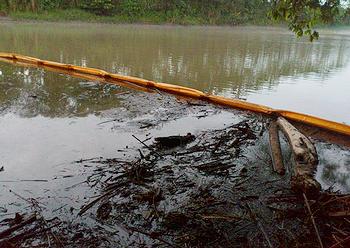
QUITO, Ecuador, June 11, 2013 (ENS) – Oil spilled from Petroecuador’s Trans-Ecuador pipeline after a May31 landslide in the Andean foothills has reached the Peruvian Amazon.
The landslide that destroyed a 330-foot section of the pipeline is blamed on heavy rain in the province of Sucumbios near the El Reventador Volcano, one of Ecuador’s most active volcanoes.

The broken pipeline spilled some 11,000 barrels, or 420,000 gallons, of crude oil into the Quijos River, a well-known whitewater adventure river on the eastern slopes of the Andes.
The oil was carried east into the River Coca, a tributary of the Napo River, which flows into the Amazon River.
The oil has polluted drinking water in the city of Puerto Francisco de Orellana, also known as Coca, a city of 80,000 and the capital of Orellana Province. Clean water is being supplied by tanker truck.
Petroecuador has also distributed food rations and cans of drinking water to the residents of 13 other Ecuadorean communities affected by the spill.
The spilled oil has now reached the Peruvian Amazon region of Loreto, and, hundreds of miles away, Brazil has been put “on alert” to watch for the oil slick.
Peruvian Environment Minister Manuel Pulgar Vidal called the spill a “very serious problem.” Peru could seek financial compensation, “but first we have to look at the extent of the problem,” he told the newspaper “El Comercio.”
Ecuadorean President Rafael Correa has apologized to Peru “for the problems we have caused.”
Petroecuador says crews have managed to contain the spread of the oil slick on a part of the River Coca and on the bottom of the river, where they have placed oil containment barriers.
The Ecuadorian government said it has taken all necessary steps to mitigate the accident.
In Peru, the Port Authority in Iquitos, in coordination with other ministries, has transported oil containment boom to the region of Cabo Pantoja on the Napo River.

The Brazilian Foreign Ministry says it has offered aid to Ecuador and Peru to support the work of containment and dispersion of the oil slick in the two countries.
Brazil’s environmental agency IBAMA, Brazil’s Navy and the national petroleum agency ANP are on standby in the event that the oil slick reaches Brazil.
The Brazilian embassies in Quito and Lima are in constant contact with the authorities in Ecuador and Peru, and Brazilian technicians remain at the disposal of the authorities of both countries, said the foreign ministry.
Today, Petroecuador coordinated a flight for officials to observe the course of the oil slick as it crossed the Peruvian border, in order to define actions required for the “cleanup and remediation of the Napo and Coca and helping communities living in that area of the Amazon,” the oil company said.
The plane carried officials from the Ministry of Environment, Petroecuador, the Risk Management Secretariat and a representative of Oil Spill Response Ltd., a company based in Fort Lauderdale, Florida, that has been hired to support emergency cleanup actions.
Petroecuador says that in the coming days the company will hire workers from communities located near or along the banks of the Napo and Coca rivers to help with the cleanup. They will work together with Petroecuador technicians to clean stones in the rivers, collect and remove waste, debris and vegetation affected by the spill.
A member of OPEC, Ecuador produces some 500,000 barrels of oil a day, most of it transported through the Trans-Ecuadorian Oil Pipeline System to refineries on the U.S. West Coast and in China.
Copyright Environment News Service (ENS) 2013. All rights reserved.
